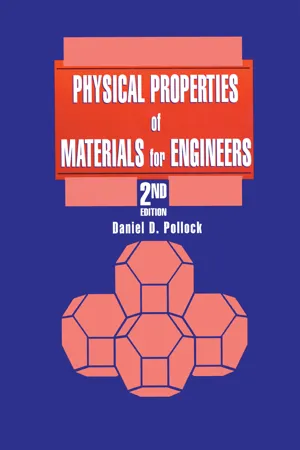
- 608 pages
- English
- ePUB (mobile friendly)
- Available on iOS & Android
Physical Properties of Materials for Engineers
About this book
Physical Properties of Materials for Engineers, Second Edition introduces and explains modern theories of the properties of materials and devices for practical use by engineers. Introductory chapters discuss both classical mechanics and quantum mechanics to demonstrate the need for the quantum approach. Topics are presented in an uncomplicated manner; extensive cross-references are provided to emphasize the inter-relationships among the physical phenomena. Illustrations and problems based on commercially-available materials are included where appropriate. Physical Properties of Materials for Engineers, Second Edition is an excellent introduction to solid state physics and practical techniques for students and workers in aerospace industry, chemical engineering, civil engineering, electrical engineering, industrial engineering, materials science, and mechanical and metallurgical engineering.
Frequently asked questions
- Essential is ideal for learners and professionals who enjoy exploring a wide range of subjects. Access the Essential Library with 800,000+ trusted titles and best-sellers across business, personal growth, and the humanities. Includes unlimited reading time and Standard Read Aloud voice.
- Complete: Perfect for advanced learners and researchers needing full, unrestricted access. Unlock 1.4M+ books across hundreds of subjects, including academic and specialized titles. The Complete Plan also includes advanced features like Premium Read Aloud and Research Assistant.
Please note we cannot support devices running on iOS 13 and Android 7 or earlier. Learn more about using the app.
Information
Table of contents
- Cover
- Title Page
- Copyright Page
- Preface to Second Edition
- Acknowledgement
- Table of Contents
- Chapter 1 Beginnings of Quantum Mechanics
- Chapter 2 Waves and Particles
- Chapter 3 The Schrödinger Wave Equation
- Chapter 4 Thermal Properties of Solids
- Chapter 5 Classification of Solids
- Chapter 6 Electrical Resistivities and Temperature Coefficients of Metals and Alloys
- Chapter 7 Thermoelectric Phenomena
- Chapter 8 Diamagnetic and Paramagnetic Effects
- Chapter 9 Ferromagnetism
- Chapter 10 Physical Factors in Phase Formation
- Chapter 11 Semiconductors
- Chapter 12 Dielectric Properties
- Appendixes
- Index